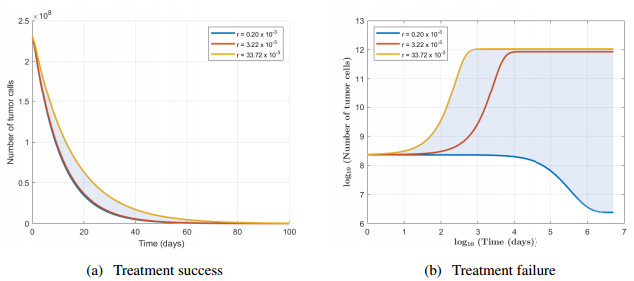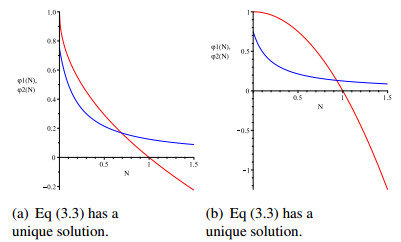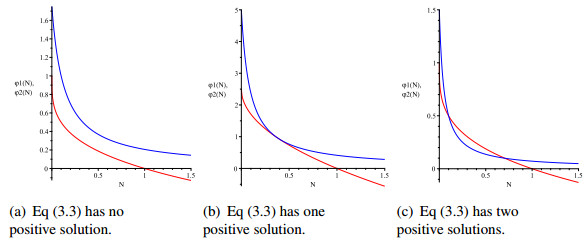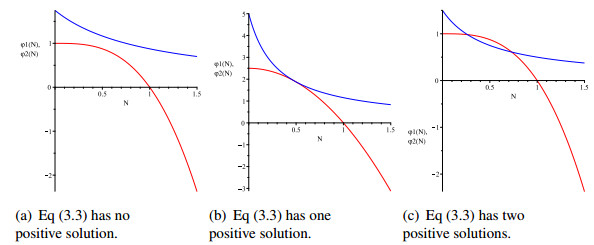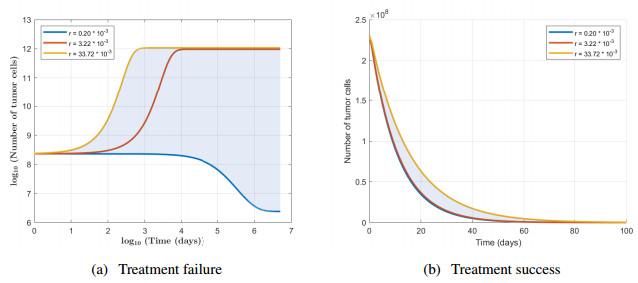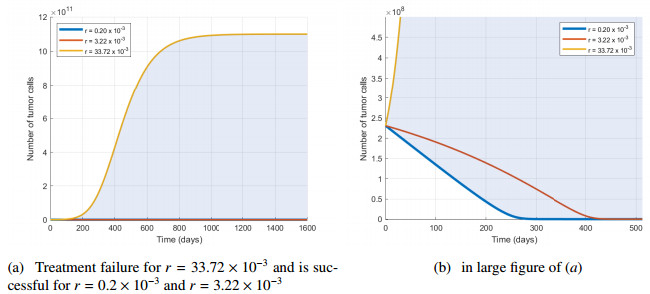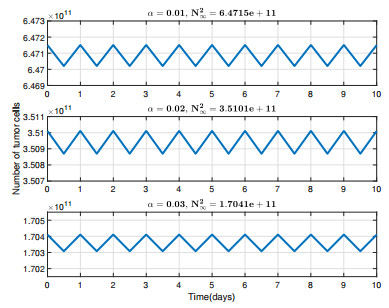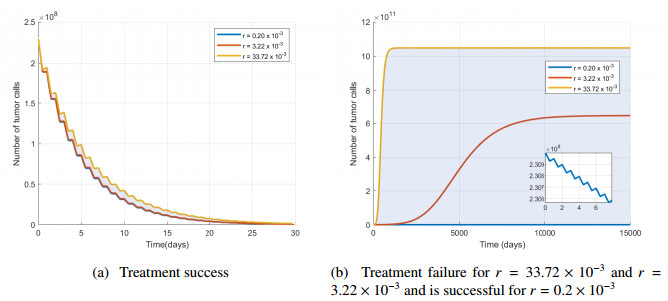1.
Introduction
Applied mathematics did not only appear because of an objective purpose, but also thanks to the human desire of always getting to know more. It is known that a quantitative description of a phenomenon observed with the formulation of laws is not enough if it does not make a qualitative study of the model along with the corresponding phenomenon. Mathematical modeling of a real problem is sometimes a difficult, long-term and very detailed process. An effective or at least close to an effective solution represents the final target of any problem. The theory of differential equations and some software packages are important tools for solving several actual problems from different real-world domains.
There are known various contributions to the investigation of solid tumor growth and chemotherapeutic scenarios. Thus, the effects of drug administration in chemotherapy are studied in the papers of R.B. Martin et al. [1] and S.T.R. Pinho et al. [2]; the fail of chemotherapy, in S.T.R. Pinho et al. [3] and D.S. Rodrigues et al. [4]; problems of optimal control of drug administration, in J.C. Panetta and K.R. Fister [5], L.G. de Pillis and A. Radunskaya [6], L.G. de Pillis et al. [7], A. D'Onofrio et al. [8]; multi-scale simulations, in G.S. Stamatakos et al. [9]; Monte Carlo models, in L.G. Marcu and E. Bezak [10]; models based on ordinary differential equations, in S.T.R. Pinho et al. [11], D.S. Rodrigues and P.F. de Arruda Mancera [12], M. Mamat et al. [13], J. Malinzi [14] and P. Unni and P. Seshaiyer [15]; and stochastic dynamic models, in W. L. Duan [16], W. L. Duan and H. Fang [17] and W. L. Duan et al. [18]. For some reviews on mathematical models for tumor growth and treatment, we refer the reader to P.M. Altrock et al. [19], A. Fasano et al. [20] and A. Yin et al. [21].
In paper [22], the mathematical model for solid tumors has been the self-limiting equation
involving three positive parameters a,b,c. The same equation has been used in [23,24,25] for modeling cell proliferation in leukemias.
Alternatively, one can use the generalized logistic equation or Richards' growth model [26],
Such an approach is given by H.M. Byrne in [27], where the following dynamic system is suggested as a model for tumor chemotherapy:
We will adopt this model for the study which follows. In this model, N(t) represents the number of the tumor cell population from a solid tumor that changes in time, A(t) is the drug concentration within the tumor at time t, and α(t) represents the rate at which the drug is injected in the body.
Parameter r represents the nonrestrictive growth rate of the tumor cell population giving the proliferative capacity of the cells, K stands for the tumor carrying capacity, θ measures how quickly the tumor reaches its carrying capacity, μ is the rate at which the drug kills malignant cells, λ represents the decreasing rate of the concentration of the drug, and γ gives the rate at which the drug is consumed significantly within the tumor. We emphasize the role of the parameter θ for the adequacy of the logistic equation to the real clinical data obtained on each type of tumor. A method for determining the value of this parameter is described in paper [28], where the criterion of best fit was the mean square error between the observed and predicted tumor values. For breast cancer, the best overall fit to the clinical data was obtained with θ=1/4.
According to the clinical practice, two cases have to be considered: (a) the case of continuous infusion, when α(t) is a constant α∞, and (b) case of periodic infusion, when the drug is delivered as a series of interrupted continuous infusions, and thus α(t) is only piecewise constant.
The scope of this paper is to perform a complete analysis of the stability of the equilibrium or stationary solutions of the Eq (1.2), as a theoretical basis of the chemotherapeutic protocols. Our results extend to a general exponent θ and some of the conclusions established in [27, Chapter 4]. The theory is illustrated and complemented by a number of numerical simulations with MATLAB and MAPLE software, using real data from the medical literature. A part of the numerical simulations was carried out on the Kotys HPC (High Performance Computing) infrastructure of Babeş-Bolyai University, Cluj-Napoca [29].
2.
The generalized logistic growth model for a solid tumor
Before starting to discuss the model of chemotherapy given by the Eq (1.2), in this first section, for comparative purposes, we remind the reader of some well-known basic results regarding the generalized logistic Eq (1.1) here considered as a model for tumor cell dynamics and the stability of its equilibrium solutions.
The solution of Eq (1.1) satisfying the initial condition N(0)=N0 can be given explicitly, namely
The equation admits two equilibrium solutions, N∗1=0 and N∗2=K. Their stability properties can be easily established and are given by the next result.
Theorem 2.1. (a) If r<0 and N0<K, then N(t)→0 as t→+∞, thus N∗1=0 is the only one equilibrium solution which is locally asymptotically stable.
(b) If r>0, then N(t)→K as t→+∞, thus N∗2=K is the only one equilibrium solution which is locally asymptotically stable.
(c) If r=0, then N(t)≡N0, thus the solution N(t) remains constantly equal with the initial value N0.
From a biological point of view, we can say that in the case of a negative nonrestrictive growth rate, as in situation (a) from the previous theorem, the population of tumor cells will be eliminated in time, see Figure 1(a). On the contrary, in the case of a positive nonrestrictive growth rate, as in situation (b), the population of tumor cells reaches its carrying capacity K, see Figure 1(b). In the case when the nonrestrictive growth rate is equal to zero, as in situation (c), the population of tumor cells remains constant in time, see Figure 1(c).
The aim of this paper is to study the influence of chemotherapy over the dynamics of the tumor cell population, in the case r>0, when, in the absence of the treatment, the tumor cell population approaches K. We are looking for conditions for the treatment to be effective, i.e. to make the transition from the bad situation N(t)→K to the good one N(t)→0 as t→+∞.
3.
Treatment of homogeneous solid tumors
Consider that a tumor grows according to the generalized logistic model, where r>0, that a drug is used to destroy the malignant cells, and that the mathematical model of the therapeutic dynamics is given by Eq (1.2).
We take into consideration two methods of treatment administration: by continuous infusion and by periodic infusion.
3.1. Continuous infusion
When the tumor is in a continuously mode exposed to cytostatic medicine, the concentrations of tumor cells and of the drug can evolve to equilibrium values. To study the impact produced by the continuous infusion of the drug, we will find and classify the equilibrium solutions of the Eq (1.2), by taking into consideration how they both depend on α∞ and therefore on the amount of medicine administered.
We consider two cases: Case Ⅰ of continuous infusion when the medicine keeps its efficiency effect (which means is not consumed within the tumor), that is γ=0; Case Ⅱ of continuous infusion when the drug does not keep its efficiency effect (which means is consumed significantly within the tumor), that is γ≠0.
Case Ⅰ:Assume that the drug keeps its efficiency effect, that is, γ=0. Then Eq (1.2) has the following form
The equilibrium points are the solutions of the algebraic system
By direct calculation, we find two equilibrium points X1(N∗1,A∗) and X2(N∗2,A∗), where
We say that an equilibrium point is admissible (from a biological point of view) if its components are nonnegative. The discussion which follows is about the admissibility and local stability of the above equilibrium points.
Clearly, the equilibrium X1 is admissible. As regards X2, observe that if r>μα∞λ, then N∗2>0, that is the equilibrium point X2 is admissible, while if r<μα∞λ, then N∗2<0 and so X2 is not admissible, without biological relevance.
Next, by the method of the first approximation (for details about the method see [30,31]), we study the stability of the equilibrium solutions. The Jacobian matrix associated to Eq (3.1) is
For X1(N∗1,A∗) we have
and its eigenvalues are
Hence, if r<μα∞λ, then the equilibrium solution X1(0,α∞λ) is locally asymptotically stable, while if r>μα∞λ, then it is unstable.
For X2(N∗2,A∗), the Jacobian matrix is
and its eigenvalues are
Hence, if rλ−(θ+1)(rλ−μα∞)<μα∞, or equivalently r>μα∞λ, then the equlibrium point X2(N∗2,A∗) is locally asymptotically stable, while if r<μα∞λ, then it is unstable.
If we put together the above results, we can state the following theorem about the local asymptotic stability of the equilibrium points of Eq (3.1).
Theorem 3.1. Let r,K,θ,μ,α∞ and λ be positive parameters. Then Eq (3.1) has the following admissible equilibrium points:
(a) If r<μα∞λ, then there is only one admissible equilibrium point X1(N∗1,A∗) which is locally asymptotically stable.
(b) If r>μα∞λ, then there are two admissible equilibrium points: X1(N∗1,A∗) unstable, and X2(N∗2,A∗) locally asymptotically stable.
From a medical point of view, conclusion (a) of the above theorem says that the treatment is successful leading to the elimination of the cancer cells provided that the amount α∞ of drug infused is large enough as the inequality α∞>rλμ shows. If on the contrary α∞<rλμ, then the treatment can only guarantee a reduction of the limit value for the tumor cell population from K to K(1−μα∞rλ)1θ.
Numerical simulations in Case Ⅰ of continuous infusion
The results of our study cover all the positive values of the parameters. For clinical applications, however, it is necessary to determine the specific values of these parameters. This aspect is intensely analyzed in the literature (see, for example [15,32,33,34]) and is not the subject of our research. Here, for the numerical simulations, we use the values of the parameters presented in Table 1.
Next, we simulate numerically the Eq (3.1) to investigate the behavior of the tumor cell population after the continuous infusion of the chemotherapy treatment when the drug is not consumed within the tumor, that is when γ=0.
The initial number of tumor cells N0 was calculated by dividing up the initial tumor volume to the individual volume of a typical tumor cell. For the initial tumor volume, we took the median value of all breast tumor volumes Vt=407 mm3 as estimated by mammography in a series of 448 patients see J.A. Spratt et al. [28]. The individual volume of a tumor cell Vc=1760 μm3 was taken from M.P. Gamcsik et al. [35], which measured breast cancer cells in culture. It appears reasonable to approximate the size of actual tumor cells in vivo by the size of the lab-grown cells. This leads to an initial number of cells equal to:
We chose a value for γ such as the consumption of the drug within the tumor (−γNA) equals the elimination of the drug by first-order kinetics such as excretion via kidneys (−λA), when the tumor is large (N approaches the carrying limit K). That is, λ=γK, or
In a previous study on a sample of 448 patients diagnosed with breast tumors, see J.A. Spratt et al. [28], the growth rate r was calculated for each individual case by regression analysis. Centrality (the median, 3.22×10−3/day) and dispersion measures (1% and 99% percentiles, 0.2×10−3/day, and 33.72×10−3/day, respectively) were then computed for the set of growth rates. We have employed these three values for r across all our simulations. They characterize synthetically the spectrum of disease severity, spanning from the slowest growing tumors (low r) to the most agammaessive (high r). The shaded area between the curves in the simulations using time-series representations corresponds to values of r between the above limits.
Case Ⅰ of continuous infusion: In this case, the drug is not consumed within the tumor, that means γ=0. Figure 2(a) shows the behavior in time (t=100 days) of the breast tumor cell population for the corresponding parameter values from Table 1, values that correspond to treatment success, when r<μα∞/λ. The breast tumor cell population N(t) and the drug concentration A(t) becomes arbitrarily close to the values N∗1=0 and A∗=α∞/λ, that means the equilibrium point X1(N∗1,A∗) is locally asymptotically stable. Figure 2(b) shows the behavior in time (t=5×106 days) of the breast tumor cell population for the corresponding parameter values from Table 1, values that correspond to treatment failure, when r>μα∞/λ. The breast tumor cell population N(t) and the drug concentration A(t) tend toward N∗2 and A∗, respectively. In this case, the equilibrium X1(N∗1,A∗) is unstable and X2(N∗2,A∗) is locally asymptotically stable.
Case Ⅱ:Assume that the drug does not keep its efficiency effect. Then γ≠0 and for the determination of the equilibrium points of the Eq (1.2), we need to solve the algebraic system
Direct calculation yields the equilibrium point
and possible additional equilibrium points of the form X(N∗,A∗), where (N∗,A∗) solves the system
and consequently, N∗ is a solution of the equation
To discuss the solvability of Eq (3.3) and the number of its solutions, it is convenient to look at the functions φ1,φ2:[0,+∞)→R,
Both functions are decreasing and
In addition, the function φ2 is convex, while φ1 is concave if θ>1, and convex if θ<1. Then, elementary geometric considerations yield the following conclusions about Eq (3.3):
(a) If r>μα∞λ, then Eq (3.3) has a unique solution N∗∈(0,K) and Eq (1.2) admits the equilibrium point X(N∗,α∞λ+γN∗).
(b) If r<μα∞λ, then Eq (3.3) may have no positive solution, one positive solution, or two positive solutions, and any positive solution belongs to the interval (0,K).
(c) If r(1+γKλ)≤μα∞λ, then Eq (3.3) has no solution in (0,K).
We can prove assertion (c) assuming the contrary, i.e., the existence of a solution N in (0,K). Then we would have
or equivalently
which yields a contradiction.
Numerical simulations for Eq (3.3)
Figures 3(a)–(b), 4(a)–(c) and 5(a)–(c) illustrate the number of solutions of Eq (3.3).
We now go to study the stability of the equilibrium solutions. The Jacobian matrix is in this case
For X1(0,α∞λ), one has
and the eigenvalues are
Therefore, the equilibrium point X1(0,α∞λ) is locally asymptotically stable if r<μα∞λ, and unstable if r>μα∞λ. Notice the same stability behavior of the equilibrium point X1(0,α∞λ) as in the case γ=0.
Assume now that there exists a solution N∗∈(0,K) of the Eq (3.3). Then
and using the equality
we obtain
The corresponding characteristic polynomial is
From the Hurwitz principle, we have that Re η<0 if and only if all coefficients of the characteristic polynomial are positive. Thus, the equilibrium point X(N∗,A∗) is locally asymptotically stable if and only if
Replacing
we obtain the equivalent condition in terms of A∗, namely
We can summarize the conclusions about the local asymptotic stability of the equilibrium points of Equation (1.2) in this case as follows.
Theorem 3.2. Let r,K,θ,μ,α∞,λ and γ be positive parameters. Then Eq (1.2) has the following admissible equilibrium points:
(a) If r>μα∞λ, then there are two admissible equilibrium points: X1(0,α∞λ) unstable, and X(N∗,A∗) locally asymptotically stable if and only if condition Eq (3.4) or equivalently Eq (3.5) holds.
(b) If r<μα∞λ, then there is at least one admissible equilibrium point, namely X1(0,α∞λ) which is locally asymptotically stable. Additionally, one or two other equilibrium points of the form X(N∗,A∗) could exist depending on the number of positive solutions of Eq (3.3), and they are locally asymptotically stable provided that condition Eq (3.4) or equivalently Eq (3.5) holds.
In the case of one equilibrium point, the treatment succeeds, but in the case of multiple equilibrium points the dynamics is sensitive to the initial conditions since it is possible that one of the equilibrium points X(N∗,A∗) is locally asymptotically stable if the condition Eq (3.4) (or Eq (3.5)) is satisfied. So, to make sure that the treatment succeeds, it is necessary to have r<μα∞λ and that the Eq (3.3) has no positive solution.
Numerical simulations in Case Ⅱ of continuous infusion
In the following, we will simulate numerically the Eq (1.2) in order to investigate the behavior of the tumor cell population after the continuous infusion of the chemotherapy treatment when the drug is consumed significantly within the tumor, that is when γ≠0. For the numerical simulations, we use the values of the parameters presented in Table 1.
Case Ⅱ of continuous infusion: In this case, the drug is consumed significantly within the tumor, that means γ≠0. Figure 6(a) shows the behavior in time (t=5×106 days) of the breast tumor cell population for the corresponding parameter values from Table 1, values that correspond to treatment failure, when r>μα∞/λ. The breast tumor cell population N(t) and the drug concentration A(t) tend toward N∗ and A∗, respectively. In this case, there exists two admissible equilibrium X1(0,α∞λ) unstable and X(N∗,A∗) locally asymptotically stable. Figure 6(b) shows the behavior in time (t=100 days) of the breast tumor cell population for the corresponding parameter values from Table 1, values that correspond to treatment success, when r<μα∞/λ. The breast tumor cell population N(t) and the drug concentration A(t) becomes arbitrarily close to the values N∗1=0 and A∗1=α∞/λ. In this case the Eq (3.3) has no positive solution, so X1(0,αλ) is locally asymptotically stable. This case is similar to the Case Ⅰ when γ=0, see the treatment success from the Figure 2(a).
In the Figure 7(a), (b) (enlarged Figure 7(a)), we can see the behavior in time (t=1600 days respectively t=500 days) of the breast tumor cell population for the corresponding parameter values from Table 1. Under the condition r<μα∞/λ, both treatment success and treatment failure are possible outcomes. As we can see, for the value of the nonrestrictive growth rate r=33.72×10−3 the breast tumor cell population N(t) and the drug concentration A(t) tend toward N∗3 and A∗3, respectively. For the values r=3.22×10−3 and r=0.2×10−3 of the growth rate, the breast tumor cell population N(t) and the drug concentration A(t) become arbitrarily close to the values N∗1=0 and A∗1=α∞/λ. In this case the Eq (3.3) has two positive solutions N∗2 and N∗3, so X1(0,α∞λ) is locally asymptotically stable, X2(N∗2,α∞λ+γN∗2) is unstable and X3(N∗3,α∞λ+γN∗3) is locally asymptotically stable.
Numerical simulations of the dependence on parameters
To illustrate the dependency of solution on the parameters, we have performed numerical sweeps for each of the six system parameters: r, θ, μ, α∞, λ and γ, see Figures 8 and 9. We have excluded from the analysis the carrying capacity K, as it has only a trivial effect on the solution (scaling). Except for the swept parameter, the fixed values are: r=3.22×10−3, θ=0.25, μ=8×10−2, α∞=0.01, λ=4.16, γ=0, K=1.1×1012. The initial conditions are: N0=2.31×108, A0=0.
3.2. Periodic infusion
In real situations, secondary effects reveal that continuous infusion is not usually considered a viable method to administrate the drug. Administered systematically, the drug can have an adverse effect on the vital organs (i.e., the liver). As a result, the chemotherapeutic drug is usually delivered as a series of continuous infusions, so that the health of the patient's organs can recover between the successive treatments. Unfortunately, this kind of method can have as a result the regeneration of the tumor.
Next, we will investigate the impact of periodic infusion considering that the tumor cell population grows according to the generalized logistic model with a nonrestrictive growth rate r>0. Thus, we assume that the cell population develops under treatment according to the model
where this time the function which describes the chemotherapeutic drug infusion A(t) is only piecewise continuous, more exactly it has the form
Here, τ denotes the duration of each period of treatment in which the drug is administered, and it is assumed that τ<1. Therefore, on a time interval [n;n+τ], the drug is continuously infused at the constant rate α∞, while on the time interval [n+τ;n+1], no drug is administered. By integration, we find the expression of N(t) on [n,n+1], namely
where Λ=1−μα∞r and Nt:=N(t). Then
and we find that the values Nn satisfy the following recurrence relation
where h is the function
The equilibrium points of the discrete dynamic process Eq (3.8), that is the solutions N∞ of the equation N∞=h(N∞) are N1∞=0 and
in case that r−τμα∞>0. Obviously, if the initial condition is N(0)=N1∞=0, then N(t)≡0 meaning that tumor cannot develop in the absence of cancer cells. By contrary, if the initial condition is N(0)=N2∞, then N(t) becomes a nontrivial periodic function Nper because Nn+1=h(Nn)=N2∞, see the Figure 10.
We now study the stability of the equilibrium points for the discrete dynamic process Eq (3.8). One has
Therefore, we can state the following theorem.
Theorem 3.3. (a) If r−τμα∞<0, then h′(N1∞)<1, which implies that N1∞=0 is locally asymptotically stable; so if N0 is in a neighbourhood of N1∞ then Nn→N1∞=0 asn→+∞ and therefore N(t)→0 as t→+∞.
(b) If r−τμα∞>0, then h′(N1∞)>1 and h′(N2∞)<1, which implies that N1∞=0 is unstable and N2∞ is locally asymptotically stable, so if N0 is in a neighbourhood of N2∞ then Nn→N2∞ as n→+∞ and therefore N(t)→Nper(t) as t→+∞.
Under the conditions of the previous theorem, in case (a), we have N(t)→0 as t→+∞, which means that the malign cells are eliminated in time, and so the treatment succeeds; in case (b), we have N(t)→Nper(t), which shows that the graph of tumor cell population stabilizes at the graph of a periodic function. Thus, when a periodic infusion takes place, the system can develop to a nontrivial periodic solution for which N(t)=N(1+t). Applying numerical simulation, we will see how N2∞ and the limit function Nper depend on the drug dose. In the simulations, the graphs show us the way that N2∞ decreases as the drug dose α∞ increases. If the drug dose is high enough, then the eradication of the tumor occurs. Obviously, with periodic infusion, the dose required to achieve eradication is greater than that required for continuous infusion. This conclusion holds because with periodic infusion, tumor cells are exposed to chemotherapy for short periods of time.
Numerical simulations in the case of periodic infusion
Next, we will simulate numerically the Eq (3.6) when the chemotherapeutic drug infusion A(t), given by Eq (3.7) is a piecewise continuous function, in order, to investigate the behavior of the tumor cell population after the periodic infusion of the chemotherapy treatment. For the numerical simulations, we use the values of the parameters presented in Table 1.
In Figure 11(a) we can see the behavior in time (t=30 days) of the breast tumor cell population after the periodic infusion of the drug, for the corresponding parameter values from Table 1, values that correspond to treatment success, when r−τμα∞<0. The breast tumor cell population N(t) becomes arbitrarily close to the values N1∞=0, that means the equilibrium N1∞ is locally asymptotically stable. Figure 11(b) shows the behavior in time (t=15000 days) of the breast tumor cell population for the corresponding parameter values from Table 1, values that correspond to treatment failure, when r−τμα∞>0 and to treatment success, when r−τμα∞<0. As we can see, when the treatment fails, for the values of the nonrestrictive growth rate r=33.72×10−3 and r=3.22×10−3 the breast tumor cell population N(t) tend toward a periodic solution Nper. For the value r=0.2×10−3 of the growth rate, the breast tumor cell population N(t) becomes arbitrarily close to the value N1∞=0. In the case when the treatment fails, the equilibrium points of the equation with differences Eq (3.8) are N1∞=0 unstable and N2∞ locally asymptotically stable, and when the treatment is successful, the only admissible equilibrium point is N1∞=0, locally asymptotically stable.
4.
Conclusions
It is natural that due to the limitations imposed by the biological environment, the mathematical models of the growth of homogeneous solid tumors should be based on self-limited equations, particularly on the logistic equation. In this paper, we worked with the generalized logistic equation of Richards. Without any medical intervention, if the nonrestrictive growth rate is positive (r>0), the tumor cell population will tend to the carrying capacity constant\ K. In order to destroy the tumor a medical treatment is necessary.
We study the dynamics of the tumor cell population in two cases of chemotherapy, the case of continuous infusion when the medicine keeps its efficiency (γ=0) and when the medicine does not keep its efficiency (γ≠0), and the case when the chemotherapeutic drug is administrated as a series of continuous infusions, so that the health of the patient's organs can recover between successive treatments. The mathematical model is given by the dynamic Eq (1.2), where α∞(t) is constant in case of continuous infusion of the drug and piecewise continuous when the drug administration is periodic. In the first case the system is autonomous, while in the second case it is nonautonomous.
From the stability analysis of the equilibrium solutions of the system, it turns out that it is necessary that the parameters satisfy the condition r<μα∞λ in order to have a successful treatment, but in the case when the medicine does not keep its efficiency this is not sufficient. In addition, it is necessary that the value of μα∞λ to be big enough - more exactly μα∞λ≥r(1+γKλ) - so that the system has only one positive equilibrium point X1(0,α∞λ), i.e.. Eq (3.3) has no positive solutions. If Eq (3.3) has a positive solution N∗, then it is possible that the corresponding equilibrium point X(N∗,α∞λ+γN∗) be asymptotically stable, and the cell dynamics becomes sensitive to the initial conditions: if the initial value is in the attraction basin of X1, then the treatment succeeds, while if it is in the attraction basin of X, then the treatment fails.
A more realistic chemotherapy treatment is that when the drug is administrated as a series of continuous infusions separated by rest periods. Then the dynamics is described by a nonautonomous system. In this case, in addition to the trivial null periodic solution, a non trivial periodic solution appears, which biologically means that the tumor cells can remain in the body. However, if the null periodic solution is asymptotically stable, then the treatment succeeds. Our result is that this happens if the condition r<τμα∞ holds. Otherwise, i.e., if r>τμα∞, then the non trivial periodic solution is asymptotically stable and the treatment proves unsuccessful.
It is noteworthy that the conditions for successful treatment never depend on the exponent θ. That is, from a treatment standpoint, the generalized logistic model behaves exactly like a plain logistic variant. In biological terms, the speed of tumor cell proliferation may modify the growth curve towards the plateau phase of tumor growth, but has no bearing whatsoever on the success or failure of chemotherapy. This interesting and counterintuitive finding may have implications for adjuvant antiangiogenic therapy, even modeled without an explicit description of tumor vascular network. However, our study highlights a certain dependence on the parameter θ, namely the value of N representing residual cancer (in the case of incomplete elimination of the disease). Therefore, we can conclude that, for the same dose, the size of the residual cancer also depends on the speed of proliferation of the tumor cells.
The mathematical analysis performed provides the necessary conditions for the success of chemotherapy, in the form of precise mathematical relationships given in terms of system parameters. Practically, the determination by theoretical and laboratory methods of the values of these parameters becomes essential for anticipating the effectiveness of treatment.
Acknowledgments
The authors would like to express their gratitude to the three anonymous reviewers for their time and effort for a careful reading of the manuscript and valuable comments and suggestions which have led to an improved version of the article.
Conflict of interest
The authors declare that they have no conflicts of interest.










 DownLoad:
DownLoad:
